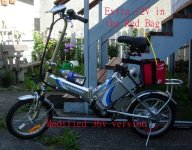This is my first new foldable ebike Schwinn AL1020 bought from CT.
The ebike has an 6061 aluminum and weights 40 lbs without battery pack.
The 24V 12Ah SLA battery pack weights about 20 lbs.
The total is 60 lbs.
A digital speedometer was installed on the RHS of the handle bar next to the throttle.
The magnet and the speed sensor were at the rear wheel.
The hub motor is a brushless motor with an internal fixed gear.
It is quite free to pedal without battery.
I am confident that the motor should be able to stand 36V with no problem.
Only thing to be concerned is the controller.
From no-load test on 24V supply, the max speed is 30km/h.
What will be the max speed on flat?
I think that it should be about 24 km/h by taking 80% of that of no-load. (To be verified ).
I road tested my ebike on flat by riding both direction on the same road with full throttle and non-pedalling.
The max speed towards North was 27 km/h and towards South was 25 km/h.
Thus the average on flat is approximatly 26 km/h which is about 85% of the no-load speed.
So my prediction is quite close.
In my opinion, 25 km/h is a bit too low. I would like if it could be 30-35 km/h on flat and it is difficult assist to pedal if the speed is above 20 km/h because it has a single-speed pedalling.
If the 36V supply could be used,
then the max speed would be 45 km/h at no-load and 36km/h on flat.
That is why I try to find an way improve it.
36 V battery supply would be the suitable soluttion if the stock controller could stand.
The ebike has an 6061 aluminum and weights 40 lbs without battery pack.
The 24V 12Ah SLA battery pack weights about 20 lbs.
The total is 60 lbs.
A digital speedometer was installed on the RHS of the handle bar next to the throttle.
The magnet and the speed sensor were at the rear wheel.
The hub motor is a brushless motor with an internal fixed gear.
It is quite free to pedal without battery.
I am confident that the motor should be able to stand 36V with no problem.
Only thing to be concerned is the controller.
From no-load test on 24V supply, the max speed is 30km/h.
What will be the max speed on flat?
I think that it should be about 24 km/h by taking 80% of that of no-load. (To be verified ).
I road tested my ebike on flat by riding both direction on the same road with full throttle and non-pedalling.
The max speed towards North was 27 km/h and towards South was 25 km/h.
Thus the average on flat is approximatly 26 km/h which is about 85% of the no-load speed.
So my prediction is quite close.
In my opinion, 25 km/h is a bit too low. I would like if it could be 30-35 km/h on flat and it is difficult assist to pedal if the speed is above 20 km/h because it has a single-speed pedalling.
If the 36V supply could be used,
then the max speed would be 45 km/h at no-load and 36km/h on flat.
That is why I try to find an way improve it.
36 V battery supply would be the suitable soluttion if the stock controller could stand.


